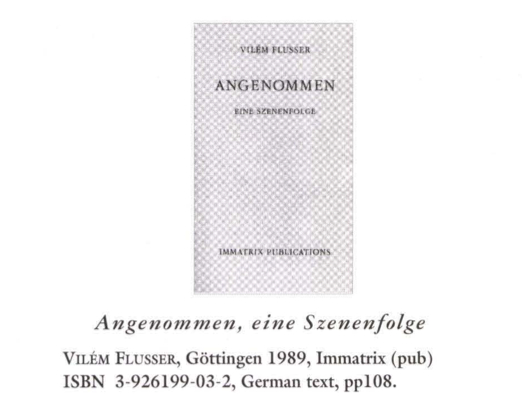Fahndung
Alljene, deren Einbildungskraft sie befahigt, die Vorste llungen und Begriffe der hier vorliegenden Szenenfolge in Videobilder umzukodieren und diese Bilder in irgendeiner Weise zu programmieren, werden hiermit aufgefordert, sich telefonisch oder schriftlich mit Immatrix Publications in Verbindung zu setzen.
Suppose we take up the above mentioned invitation proposed by Immatrix, the publishers of Flusser’s book Angenornrnen. What exactly would lie in store for us?
At the beginning of the book the publishers request contact with all those able to use their imagination to translate the ideas and concepts of Flusser’s scenario into programmable video images.
Is Flusser aware of the fact that not much would survive of his vague, futurist utopia couched in pseudo-prophetic parables? Translation into a new telematic code - or whatever you want to call it - would entail the improper use that is the result of an amnesia of literary discourse. Nonetheless an exciting - although completely disparate - relation between the 'scenario' book and video (etc.) may be possible. Unfortunately neither Flusser nor his publishers have thought enough about what this kind of translation from one mode of knowledge into another {McLuhan) would ultimately look like as seen from the perspective of writing. Had they done so they would have been able to make an interesting contribution to an important theme. Here, the small light-bulb of conjecture is not destined to become the ’laser-beam' of revelation.
In addition: precisely which ideas are the publishers trying to protect with the copyright announcement that all rights are reserved and that that includes any interpretation (in sound and image?) plus all parts thereof. (This was also the case with Flusser’s Schrift which was also published on floppy). Exactly who is the author and who is the reader? What kind of risks, epistemological, technical, financial and legal, are involved for the reader attempting to ‘transcode’ and ‘program’ Flusser’s ideas. We would be most grateftil for any clarification provided.
